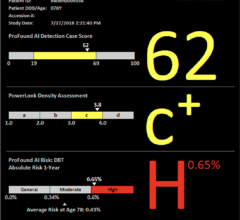
December 13, 2011 – Molecular breast imaging (MBI) has been found to be equivalent to magnetic resonance imaging (MRI) as an adjunct imaging modality in the diagnosis of breast cancer. MBI may be especially useful for the evaluation of high-risk women or those with dense breasts.
According to the study authors, MRI has become increasingly popular as an adjunct to mammography in the diagnosis of breast cancer. Despite its sensitivity in lesion detection, MRI is expensive and can cause patient discomfort. MBI has similar sensitivity to MRI, costs less and is comfortable for the patient. This study aimed to directly compare the two modalities.
It was concluded that MBI results led to further workup and detection of occult malignancies. In fact, negative MRIs without contradictory MBI results would have led to six missed malignant tumors in this study. Also, the authors noted that as the study demonstrated MBI’s equivalency to MRI in the diagnosis of breast cancer, that MBI may be useful for the evaluation of high-risk women or those with dense breasts. For this study MBI was conducted with a high-resolution gamma camera, the Dilon 6800.
Beyond demonstrating that MBI is equivalent to MRI in the diagnoses of breast cancer, Nathalie Johnson, M.D., chief breast surgeon at Legacy Good Samaritan Hospital in Portland, Ore., and author on this study, said, “Its application may be particularly relevant for evaluation of newly diagnosed breast cancer to rule out additional disease with a lower false positive rate.” Additional researchers on the study were Esther Han, M.D. and Margie Glissmeyer in Portland, Ore.
As a follow-up to mammography, MBI utilizes the Dilon 6800 gamma camera to help physicians more clearly differentiate benign from malignant tissue. To perform MBI, the patient receives a pharmaceutical tracing agent that is absorbed by all the cells in the body. Due to their increased rate of metabolic activity, cancerous cells in the breast absorb a greater amount of the tracing agent than normal healthy cells and generally appear as dark spots on the MBI image.
For more information: www.dilon.com


 July 29, 2024
July 29, 2024 








